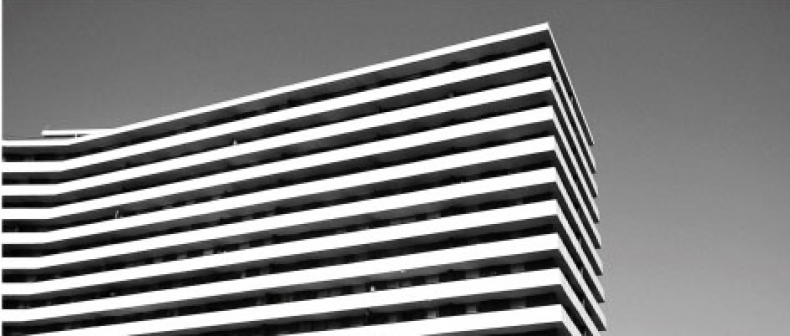
They’re the unacknowledged icons of Toronto – those modernist highrise apartments, the Corbusian towers in the park that stand sentinel across the city’s inner-suburbs. As much as “Red Rocket” streetcars or Viljo Revell’s New City Hall they are a defining, if rarely praised, feature of Toronto’s visual landscape.
And they’re more than that. The towers and the neighborhoods around them constitute Toronto’s places of arrival. It’s where the majority of its immigrants gain their first, almost always tenuous, toe-hold in the city.
An architect, researcher and writer, Graeme Stewart has worked to raise awareness of the some 2,000 post-war residential high-rises as the GTA’s neglected asset. It’s because of them that the city boasts a population density twice that of Chicago, and contrary to opinion, is not quite the sprawling mess it could’ve been. But the towers, though solidly built, are aging fast and in dire need of rehabilitation. Further, last year’s Vertical Poverty report by the United Way found that the immigrants housed inside them are falling ever further behind economically.
In the book Concrete Toronto (co-edited with Michael McClelland) Stewart argued for a reconsideration of the city’s post-war modernist architecture. Now, as a founder of the Tower Renewal Project, he’s behind the movement to transform those apartment tower neighborhoods into more liveable zones of urban innovation.
The Standard spoke with Stewart at the offices of ERA Architects, where he is an Associate.
What was the impetus for the Tower Renewal Project?
These inner suburban high-rises are a 40-year-old idea frozen in time, and they haven’t received a lot of investment since they were built. Nor have the neighbourhoods around them.
Two things have happened. First, the buildings are inefficient, they’re getting old, and in some cases needing significant repairs. Second, they were designed for a completely different, car-owning demographic. These high-rises began as medium-income and, in some cases, luxury housing for young couples. It was the original condo boom. Now the area is a reception zone for new Canadians. They were affordable, so they became perfect places for arrival.
But when those things compound you have these high-density areas that are very fragmented, they’re not meeting the needs of residents, and are pretty inflexible.
The project proposes we begin thinking of these buildings as assets rather than liabilities.
The opportunity is there for them to become vibrant, mixed-use centres. If we’re thinking about sustainable property in the city, what better starting point than where a lot of interesting people live in a high-density scenario with lots of open space? It’s a great starting point for thinking about how a city can grow.
Nowadays we talk a lot about sustainable cities, but it’s problematic to think that problems will be solved through new construction, like a few landmark green office towers in the centre, or a few green communities at the edges. That’s nice but really symbolic more than anything. Most of the city is already built. What do we do with the existing city?
Even if you figure out downtown, it’s the suburbs that are the most carbon-intensive and problematic. If you compare us to Chicago, because we’re both cities by the lake, we’re in a better position to look toward the future because we have this decentralized high-density, these nodes carpeted throughout the inner-suburbs – giving the Toronto area double the regional density as greater Chicago. These tower clusters are found not just in Toronto but throughout the Golden Horseshoe.
Re-imagining suburbia is a popular topic among urbanists these days. How do these tower neighbourhoods fit into that discussion?
There’s been enough time now to realize that not only is it irresponsible not to look after these neighbourhoods, but it’s in the inner suburbs where innovation most likely to come from. There are only so many in-fill boutique things you can do downtown. We’ve figured that out – the places in need innovation is outside of downtown. Our inner suburbs were in fact quite planned, albeit through the lens of the 60s and 70s. Yet their fabric of communities planned around the neighbourhood unit, the ravine system, shopping centres, community parks and schools and so on, and especially the high density tower clusters in question, provide a very good starting point for investment and evolution. There’s so much opportunity.
And what we’re talking about is already happening all over Europe. Sometimes we spend so much time dealing with local challenges you think this is a radical proposition, when in fact it’s been happening there for 20 years. We have to think of these buildings as having a second lifecycle, liberalizing land use restriction – such as allowing for mixed use, from green grocer to innovation hub – flourish. Taking the 20th century fabric of the city and adding 21st century sensibilities, from community gardens and small business development to greener buildings.
What are the key aspects of tower renewal?
There are two arenas in play. One is the area and neighbourhood around the building, where just about anything could happen, and the other is the buildings themselves which are actually remarkable concrete frame buildings. You could take the ground floor, which is often now storage, and turn it into restaurants or cafes. Theoretically, you could combine units and make larger units, or you could build out from the building. You could use them as the starting point for some pretty interesting interventions.
How do you address their age and energy efficiency?
Dealing with the envelope is a big one, the windows and walls. You could refurbish them with over-cladding. You could put a bunch of solar, photovoltaic panels on them, introduce solar water heating, ground source heat pumps. All the things a new building can do you can retrofit [onto these buildings].
The lack of ground floor retail is part of what often makes the areas around these buildings dead space. Isn’t half the battle simply the boring, bureaucratic stuff of zoning laws?
A lot of what we’re advocating for, and what the city is struggling with, is that most of these buildings fall under rigid suburban zoning laws. They’re single-use only, at most there’s a little tuck shop in the bottom.
If you’re someone in the neighborhood who wants to open a shawarma place in the ground floor of your building you have to go through a two-year rezoning process and hire a bunch of lawyers. That’s not going to happen. One of our priorities is to push for a rezoning of these sites that allows for low-impact mixed use. The way we describe it is that it’s about supporting entrepreneurs, social innovation and cutting red tape.
You mentioned that tower renewal is already happening in Europe. What are some of your favourite examples?
There are two examples that I really like. One is what’s happening in Eastern Europe, in Russia, the more carnivalesque stuff. It’s not about building retrofits, it’s about people using the space around their buildings and re-purposing the base of their buildings for commerce, for daycares, for all sorts of things. The message of Eastern Europe is that these places can have really vibrant local economies.
Another more top-down Western European approach is in Amsterdam, in a neighborhood called Bijlmereer. There they added a significant amount of new housing, and it’s the same demographic we would build new houses for in Markham: young professional families.
So they targeted that market around the base of these buildings, very smart, family-oriented mid- and low-rise buildings. Some of which were affordable, and mixed in a large cultural and retail program, and brought in a subway. I think that’s the kind of thing that would make sense in Toronto, especially in places like Etobicoke and North Scarborough.
Let’s go back to the origins of these buildings. As both Concrete Toronto and the literature for the Tower Renewal Project point out, their architecture, their planned nature, and the sheer number of them in the inner suburbs are what distinguish Toronto from any other city in North America. And you believe they’re part of the reason for the city’s success. How did this happen?
For whatever reason we just took a different course than the U.S. There were the same pressures, the same forms of suburbanization. Yet in Canada and especially Toronto during this period, we weren’t afraid of high-rises in suburbs, it wasn’t anti-Canadian. Living in a bungalow was obviously part of the Canadian dream, but people also thought living in these Jetsons-style, super sexy high-rises could also be synonymous with the Canadian dream, similar to the condo boom today. The U.S. model was more like every family deserves a detached single family home. That’s not a very flexible way to think.
I’m fascinated with Toronto from that era because it wasn’t afraid to think to the future and be radical. And these things we did were pretty radical. We always hear how the Toronto region is so sprawling and out of control, but between 1960 and 1980, the number of apartment units outpaced single family homes by a ratio of two to one.
This left a completely different city than anything you’d find elsewhere in North America. When I started travelling, looking at Moscow, Berlin, London, Amsterdam, Belgrade, I saw the similarities. The biggest difference was that most of theirs were state-sponsored projects, whereas in Toronto it was mostly private market. In a weird way all these high modernist ideas landed in Toronto and somehow merged with the private sector and they just went for it. It caught on, it was a money making machine.
I’ve spent a fair bit of time in Moscow and was always surprised, between the brutalist architecture and apartment blocks, how much it seems not so distant from Toronto.
When I was in suburban Moscow being driven around by this older Soviet architect, saying he built this and that – I thought, wow, this feels like Scarborough. I felt at home!
Where did this European connection come from?
A lot of it comes from our colonial relationship to Europe. The planning department here was set-up by British ex-pats who decided the city needed a planning school at the University of Toronto. People like Peter Dickinson and many of the other major architects at the time were Brits doing their stint in the colonies.
Then there was this wave of other Europeans who came here after the war, people like [Estonian-born architect] Uno Prii and so on. Even the concrete trades were largely Italian tained at home. This was a great period of exchange from which Toronto really benefited.
Michael Ondaatje’s In the Skin of a Lion is probably the most highly regarded novel about the building of the city, with its narrative based around the construction of the Bloor Viaduct and R. C. Harris Water Treatment Plant and the immigrant experience. Concrete Toronto‘s essays to me feel like a non-fiction, latter-day equivalent. It describes how the city was shaped by some compelling personalities usually absent from our history.
Yeah, it’s all about the protagonists. An example is this remarkable character – a planner named Hans Blumenfeld. He was a card-carrying Communist who fled Germany who went to the Soviet Union, and was later kicked out. He went to New York and Philadelphia, but during the Red Scare and the McCarthy era he got kicked out of there, too. He found himself in Toronto. It was the only place that would have him.
Within Toronto he was able to become an incredibly influential planner and bring a lot of these highly socialist planning ideas to the mainstream. These buildings look like European social welfare state housing, and are embedded with a lot of the same ideas, such as mixing them into the suburbs, providing affordable housing within growing communities, pairing them with bus lines and all that stuff. The weird thing here is that the only reason it flew was because it was all privatized. The Metro government would say “this is how this neighborhood will work, it will contain x number of high rise units” and the private companies would say, “Okay we’ll build that.” They found a market for it.
There was this weird convergence of high-level modernist planning and architecture with a development community that, in light of post-war growth, was happy to build it. And then there were a bunch of people who were happy to live in it.
And we overlook actually how adventurous the architecture of that time could be.
Part of what we were trying to do with Concrete Toronto was give people a different reading of the city, as opposed to, “Oh, those buildings are ugly, they are disruptive to my version of Toronto being the quaint old Annex or whatever.” But this is actually what the city is made of.
At the point where we built New City Hall, Robarts, the Gardiner, the CN Tower, the city was young, and perhaps nave and all that stuff. But it was also saying we’re a big deal, we’re looking to the future.
Do you feel that the book has in some measure changed the way we talk about and regard our local architecture?
I don’t think were quite ready to say yes, but in the circles I run in I’ve noticed a thawing of the initial assumption that anything from that era is bad. People used to talk about these modernist buildings with horror. Now it’s become kind of trendy to like brutalism, and to like modernism. There’s even nostalgia for modern planning, one that I share. Even though they messed it up, and even though a lot of the ideas were flawed, there was still a positive idea there about building communities, that we can still learn from.
Do you find it ironic that Toronto was back then home to North America’s biggest apartment building boom, and it’s the same now in the case of our condo boom?
It’s totally ironic. It’s interesting when you see these two peaks, the apartment boom and the condo boom, although statistically the apartment boom of the ‘60s and ‘70s still dwarfs what’s happening now. But it shows that density is the real wave in Toronto, that those other periods are the gullies, reactions where people are questioning it.
We’re still very nave as a city in terms of housing and housing types. All we’re building now is point towers and stacked town homes. We’re not building for the demographic that’s about to explode: young families. We’re not building European-style mid-rise family based housing. There could be a large market for that, especially if were serious about an alternative to sprawl. There is in fact huge room for innovation for family housing, and affordable family housing in Toronto.
About fifty years on we’re talking about a second lifecycle for those modernist high-rises. In the future what will we be saying about these new condos?
It’s a shame the condo boom took off before the green trend became entrenched. Some of these buildings are built as inefficiently as any of these older towers. The window-wall systems are going to require upgrade in the years to come, and retrofitting them may in fact be more of a challenge than the older towers, as they may require the removal of the entire envelope, floor by floor. Thats not to say that some of the condos arent quite good – as they are. But all buildings age and there will be challenges. We’ll see how that goes.
Under David Miller, tower renewal was adopted as official city policy. Where is the project at now?
The real trick of working with the city is that it’s really slow. Policy change – you have to chip away at it. There’s an official plan update underway and an opportunity for these ideas to get there.
Increasingly, there’s willingness from owners [to provide leadership]. A lot them have been pushed to the wall with negative press over the years: the buildings are poorly maintained, they’re seen as bad actors. This project has been a bit of an olive branch to say, you guys can be a huge part of the solution and these buildings you own are really important. And there are tools to increase your property values. And many are forging ahead – and in fact some have been at it for years.
This is a 20-year project. We’re talking about a huge number of buildings, hundreds of neighbourhoods an over a million people live. It’s about a gradual process of improvement. For now, it’s working in specific communities with different landowners, asking whether we can take down some fences, rezone for mixed use, introduce some modest demonstration projects regarding community development and building upgrade. Then we can make these new ideas viral, the new status quo. Over the long term, this can provide real opportunities for a more sustainable and livabl city-region.
These building arent going anywhere, but the longer we wait, the more difficult the challenge. It’s time to get going.














